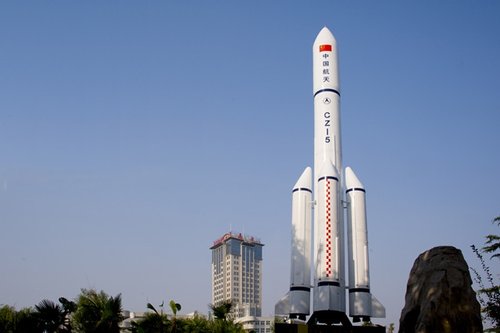

 |
| The Long March-5 rocket(File photo) |
BEIJING, March 23 -- The second ground test of the power system of China's next-generation carrier rocket was completed Monday, ahead of its first flight in 2016.
Using non-toxic, non-polluting liquid propellant, the engines of Long March-5 were test-fired on the ground to test current technology, said Tan Yonghua, head of the Academy of Aerospace Propulsion Technology.
Long March-5 was first test-fired on Feb. 9 this year.
According to Xu Dazhe, head of the State Administration of Science, Technology and Industry for National Defense, Long March-5 will increase China's ability to enter the space by at least 2.5 times, largely improving the country's carrier rocket.
The Long March-5 rockets, designed for the final chapter of China's three-step -- orbiting, landing and returning -- lunar program, will have a payload capacity of 25 tonnes to low Earth orbits, or 14 tonnes to geostationary transfer orbit.
"The Chang'e-5 lunar mission is undergoing intensive development and is scheduled to be launched with a Long March-5 carrier rocket from south China's Hainan Province around 2017," said Xu.
China started work on carrier rockets in 1950s. Long March rockets have since become the main carriers for satellites, probes and manned spacecrafts.
In December 2014, the CBERS-4 satellite, jointly developed with Brazil, was launched from the Taiyuan base by Long March-4B rocket, the 200th launch of the Long March rocket family, making China become the third country, after the United States and Russia, to complete 200 carrier rocket launches.
 J-11 fighters in air exercise
J-11 fighters in air exercise Beauties dancing on the rings
Beauties dancing on the rings Attendants-to-be join Mr. & Miss Campus Contest
Attendants-to-be join Mr. & Miss Campus Contest Beijing's toughest anti-smoking law takes effect
Beijing's toughest anti-smoking law takes effect Family lives in cave for about 50 years in SW China
Family lives in cave for about 50 years in SW China PLA soldiers operating vehicle-mounted guns in drill
PLA soldiers operating vehicle-mounted guns in drill Blind carpenter in E China's Jiangxi
Blind carpenter in E China's Jiangxi China hosts overseas disaster relief exercise for the first time
China hosts overseas disaster relief exercise for the first time 20 pairs of twins who will become flight attendants in Sichuan
20 pairs of twins who will become flight attendants in Sichuan Obama is sowing discontent in S.China Sea
Obama is sowing discontent in S.China Sea Rescuers work through night to reach cruise ship survivors
Rescuers work through night to reach cruise ship survivors Driving through limbo
Driving through limbo Facing down MERS
Facing down MERSDay|Week